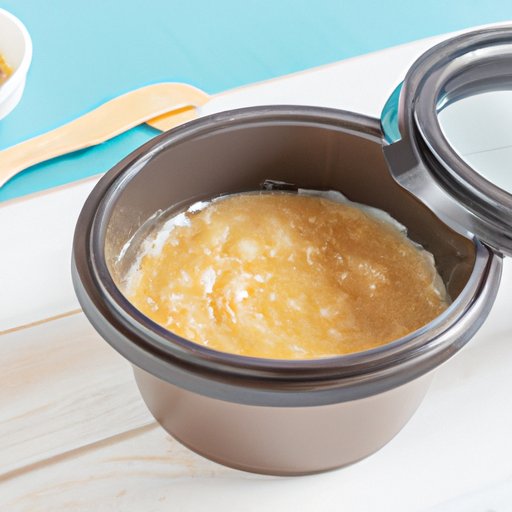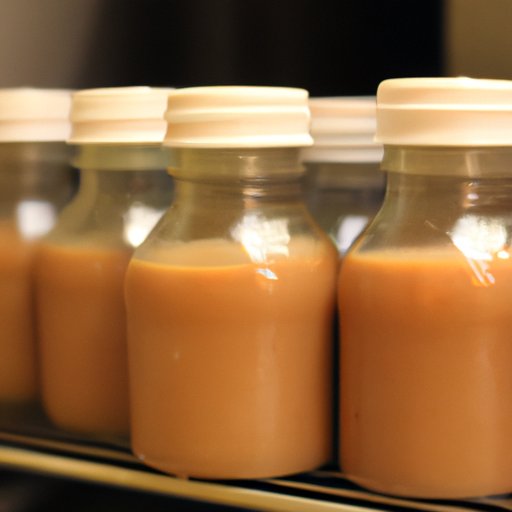Introduction
Gravy is a classic addition to many meals, but it can be frustrating to make it from scratch every time you want it. Fortunately, we’ve got a solution – freezing gravy. You can easily store gravy in your freezer and have it ready to go next time you make a meal. In this article, we’ll explore how to freeze gravy, the best containers to use, how long to freeze it, and tips on how to best thaw it out. We’ll also explore other benefits of freezing gravy and tips for preventing gravy waste.

Freezing Gravy: Tips and Tricks to Make Your Meal Preparation Easier
Step-by-step Guide to Freezing Gravy
To freeze gravy, you’ll need to follow a few simple steps:
- First, make sure that the gravy has cooled completely to room temperature before freezing. If you freeze it too soon, it could form ice crystals, causing the texture and flavor to change.
- Next, choose an appropriate container. Airtight containers are key to preventing freezer burn and maintaining the flavor and texture of the gravy.
- Fill the container with gravy, leaving at least an inch of space at the top to allow for expansion during freezing.
- Label the container with the date and contents of the gravy.
- Finally, place the gravy in the freezer. For best results, store in the back of the freezer away from the door to prevent temperature fluctuations.
Tips for Selecting the Best Containers for Freezing Gravy
Choosing the right containers can make a big difference in how well your gravy freezes and thaws. Here are some tips:
- Use airtight containers to prevent freezer burn and ice crystals from forming.
- Plastic containers are typically better at preventing freezer burn than glass jars because they are more durable, resist cracking, and won’t break in the freezer.
- Cube-shaped containers are useful for freezing small portions of gravy that you can easily thaw as needed for everyday use. You can also use resealable plastic bags if you plan on using the gravy in a relatively short period of time.
How Long to Freeze Gravy and Best Practices for Thawing It
Gravy can be stored in the freezer for up to 3 months, after which it may start to lose its flavor and texture. Here are some tips for thawing gravy:
- Transfer the container of frozen gravy from the freezer to the refrigerator 24 hours before using it to let it thaw completely.
- Once thawed, reheat the gravy in a pot on the stove over medium heat until it is heated through.
- To avoid changes in texture and flavor, avoid freezing gravy with ingredients that may not freeze well, such as potatoes or some meat chunks.
Batch Cooking: How Freezing Gravy Can Save You Time and Money
Explanation of How Batch Cooking Can Improve Meal Preparation and Save Money
Batch cooking involves making a larger quantity of a meal and freezing it for later use. It can be very helpful in terms of time management and cost savings in meal preparation. This includes gravy. Here are some benefits:
- Batch cooking saves time, as you only need to cook once for several meals, reducing overall cooking time.
- Batch cooking can be more cost-effective, as buying ingredients in bulk can often be cheaper and reduce food waste.
- Batch cooking ensures you have homemade meals ready for when you’re too busy during the week or unexpected guests drop by.
Tips for Batch Cooking Gravy and Freezing It for Later Use
Here are some tips for batch cooking gravy:
- Scale up the recipe, making a larger batch of gravy to store in the freezer in portions for future use.
- Cook your gravy in a large pot for easy stirring and prevent overflowing.
- Cooking gravy in a crockpot or slow cooker also makes it easier for batch cooking.
- Store your batched gravy in airtight containers or sealable bags in serving-size portions to make it easier to use in smaller quantities.
Recipe Ideas for Using Frozen Gravy in Various Meals
Now that you have gravy on hand, here are some ideas on how to use it:
- Drizzle gravy over meat or vegetables for an easy and satisfying meal.
- Add it to stews and casseroles for added flavor.
- Use it as a quick and easy sauce for pasta or rice dishes.
- Create gravy bowls with leftovers from your holiday dinners.
Don’t Waste Your Gravy! Learn How to Freeze and Reuse Leftovers
Strategies for Preventing Gravy Waste
Gravy often gets wasted because it spoils quickly. Here are some tips to prevent gravy waste:
- Make just enough gravy to serve and avoid making too much.
- Store leftover gravy in airtight containers and refrigerate it instead of keeping it on the stove for too long.
- Divide leftover gravy into portions and freeze them in airtight containers for use later.
- Use gravy in creative ways such as making gravy bowls.
Tips for Storing Leftover Gravy for Later Use
When you have leftover gravy, you can freeze it to use later or repurpose the leftovers:
- Cool the gravy before storing it in the fridge or freezer.
- Store in an airtight container to prevent freezer burn or spoilage.
- Label the container with the date and contents.
Ideas for Incorporating Leftover Gravy into New Dishes
When leftovers accumulate, it can be boring to eat the same foods twice. Here are some ideas on incorporating leftovers like gravy into new dishes:
- Create gravy bowls by combining mashed potatoes, turkey, or chicken with gravy for a delicious meal.
- Use leftover gravy as a base for soups or stews.
- Make a gravy-based sauce to top pasta or rice dishes.
- Use gravy as a marinade for meat and vegetables.

Savor the Flavor: How to Freeze Gravy Without Compromising Its Taste and Texture
Explanation of How Gravy Can Change When Frozen
Gravy has a high moisture content and can form ice crystals that cause changes in texture and flavor when frozen. Here’s what you can do to prevent this:
- Select a thickening agent that is less likely to separate or become difficult to stir on freezing.
- Thicken the gravy a little more than usual so that it stays thick after thawing.
- Consider preparing a small portion of the gravy without thickener to freeze. This way, you can add it to other sauces, soups, or stews later for added flavor and texture.
Tips for Preserving the Flavor and Texture of Gravy while Freezing It
Here are some tips to preserve the taste of gravy when freezing:
- Do not overcook the gravy. The longer it cooks, the more likely it is to break when frozen.
- Use high-quality ingredients for your gravy that retain their flavor after freezing. Try to use fresh herbs, spices, and aromatics rather than canned or dried ones.
- Cool the gravy to room temperature before placing it in an airtight container for freezing.
Recommendations for Reheating Frozen Gravy to Maintain Its Quality
Here are some tips for reheating frozen gravy and maintaining its texture and flavor:
- For best results, thaw the gravy naturally in the refrigerator overnight.
- Use a low heat setting when reheating the gravy on the stovetop.
- Stir the gravy frequently to distribute heat evenly.
- If the gravy becomes too thick after thawing, gradually add water or broth until the desired consistency is reached.

From Thanksgiving to Weeknight Meals: The Ultimate Guide to Freezing Gravy
Ideas for Incorporating Gravy into Meals beyond Thanksgiving
You don’t need to wait for the holidays to use gravy. Here are some ideas on using gravy in everyday meals:
- Drizzle gravy over meatloaf or meatballs for added to the flavor.
- Use gravy as a base for pot pie filling.
- Top biscuits with gravy for a Southern-style breakfast.
- Use gravy for a quick pasta sauce with a twist.
Tips for Freezing Small Portions of Gravy for Quick Use
If you want to use your frozen gravy in small portions instead of defrosting an entire container, here are some tips:
- Use ice cube trays to freeze small portions of gravy for easy access when needed.
- After the cubes are frozen, transfer them to a resealable plastic bag for easy storage.
- Mark the bag with the date and contents before returning it to the freezer.
Recipe Ideas for Using Frozen Gravy in Everyday Meals
Here are some examples of using frozen gravy in everyday meals:
- Use the frozen gravy cubes to make a quick and easy sauce for vegetables or meat.
- Make a gravy-based pizza sauce to change up your pizza-night routine.
- Make a gravy-based soup requiring minimal ingredients.
- Bake a frozen gravy cube in hollowed squash halves for a hearty meal.
Conclusion
Freezing gravy is an easy way to cut down on meal prep and prevent food waste. By following our tips, you’ll be able to freeze gravy successfully and store it for up to three months. Batch cooking gravy can save you time and money, and leftover gravy can be repurposed into many tasty new dishes.
With these tips and ideas, you’ll be able to make the most of your gravy for many meals to come.
